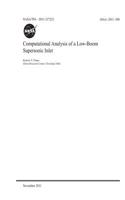
Computational Analysis of a Low-Boom Supersonic Inlet
Series:
A low-boom supersonic inlet was designed for use on a conceptual small supersonic aircraft that would cruise with an over-wing Mach number of 1.7. The inlet was designed to minimize external overpressures, and used a novel bypass duct to divert the highest shock losses around the engine. The Wind-US CFD code was used to predict the effects of capture ratio, struts, bypass design, and angles of att
NaN
VOLUME
English
Paperback

A low-boom supersonic inlet was designed for use on a conceptual small supersonic aircraft that would cruise with an over-wing Mach number of 1.7. The inlet was designed to minimize external overpressures, and used a novel bypass duct to divert the highest shock losses around the engine. The Wind-US CFD code was used to predict the effects of capture ratio, struts, bypass design, and angles of attack on inlet performance. The inlet was tested in the 8-ft by 6-ft Supersonic Wind Tunnel at NASA Glenn Research Center. Test results showed that the inlet had excellent performance, with capture ratios near one, a peak core total pressure recovery of 96 percent, and a stable operating range much larger than that of an engine. Predictions generally compared very well with the experimental data, and were used to help interpret some of the experimental results. Chima, Rodrick V. Glenn Research Center NASA/TM-2011-217223, AIAA Paper 2011-3801, E-17906
Price Comparison [India]
In This Series
Bestseller Manga
Trending NEWS




















